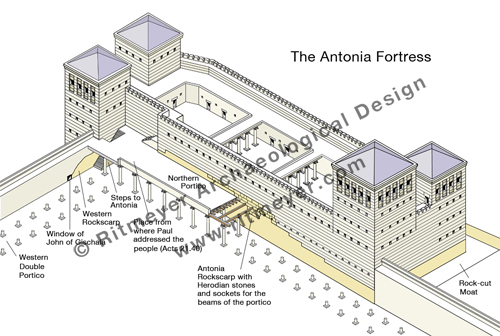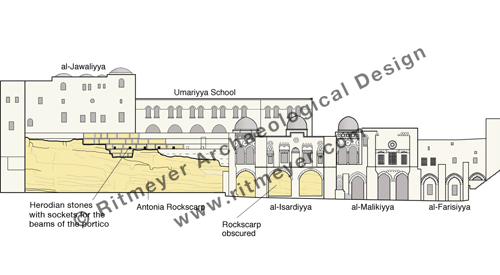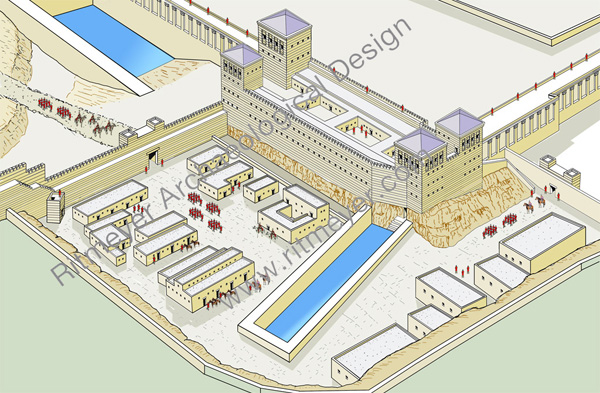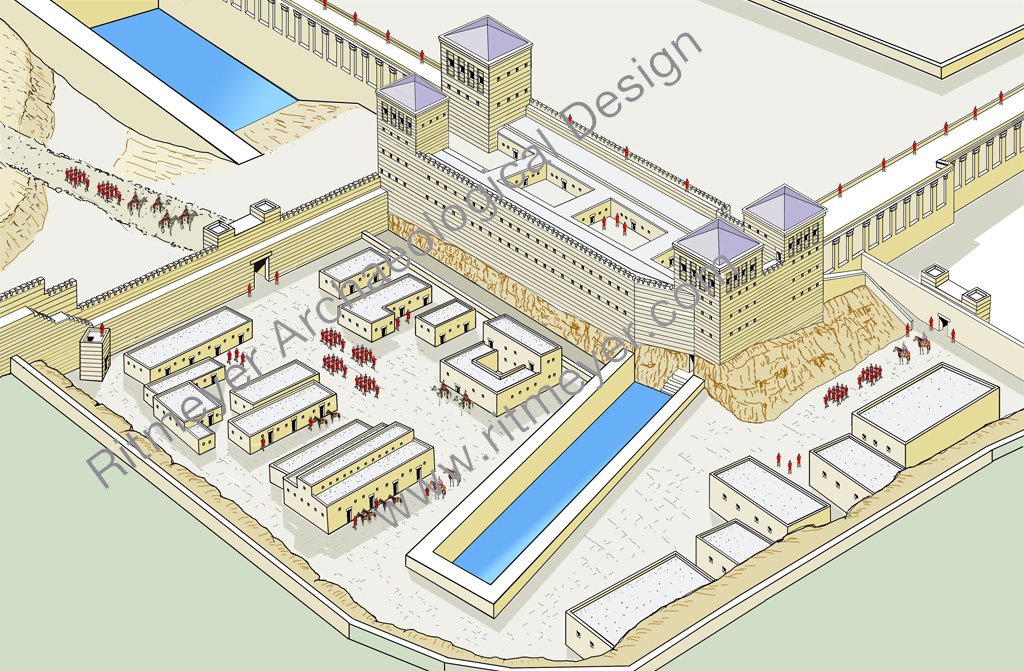One of my readers, Daniel Wright, commented on my previous blog: “Once again Leen, I would like to thank you for addressing the persistent “temple location” confusion. I frequently get questioned as to my point of view on the “City of David” location theory. Directing the inquisitive to your blog is a real asset. It is important and useful to remind readers that you worked directly for Dr. Benjamin Mazar and you were also a contemporary of Ernest L. Martin, as both of you were there in Jerusalem during the same timeframe. Your personal involvement with Mazar’s team as these things were discovered, and your role as archaeological illustrator make you a primary authority on this topic. I am grateful that you continue to publish materials that address this needless controversy.”
Thanks, for the encouragement Daniel. As promised, I now hope to deal with yet another aspect of the Temple Mount that proponents of the City of David location often bring up in support of their theory, i.e. the Antonia Fortress.
These theorisers have a problem with the existing walls of the Temple Mount and have therefore suggested that they must have belonged to the Antonia Fortress that stood north of the Temple. Such a suggestion shows ignorance of and contradicts the historical sources and archaeological evidence. Let’s begin with the historical sources.
Josephus wrote (War 5.238-246) that the Antonia Fortress was built on a rock that was 50 cubits (86 feet or 26.25m) high. The fortress had towers at its four corners. Its interior had apartments, cloisters, baths and courtyards, and looked like a palace.

Anyone who has seen a section of the Herodian Temple Mount knows that it could never be said that Temple Mount stood on such a rock. In fact, the platform swallows up Mount Moriah beneath it.
Another problem that is raised is that the accepted location of the Antonia Fortress is thought to be too restricted an area. What do the historical sources have to say about this? In War 5:244 Josephus mentioned that:
“a Roman cohort was permanently quartered there, and at the festivals took up positions in arms around the porticoes to watch the people and repress any insurrectionary movement.”
How to understand this statement? Although the rock plateau on which the fortress stood is a sizeable piece of real estate, measuring approximately 148 feet (45 m) from north to south and 394 feet (120 m) from east to west, it is indeed difficult to imagine that a cohort of about 500 soldiers and their horses could have camped inside this fortress
However, I believe that it would be a mistake to limit the boundaries of the Antonia to the rocky plateau only. The Strouthion Pool, for example, would have provided water for the Roman soldiers garrisoned here and would have been protected. At a distance of about 60m to the north is a high rock scarp that enclosed a large area where later the eastern Roman Forum was built. It is reasonable to suggest that the common soldiers camped out here in semi-permanent barracks, while the officers and commanders stayed in more luxurious and permanent accommodation on top of the Antonia rockscarp.
Another difficulty in suggesting that the Temple Mount was the Antonia, is what Josephus writes about its destruction by the Romans:
“Titus now ordered the troops that were with him to raze the foundations of Antonia and to prepare an easy ascent [into the Temple Mount] for the whole army” (War 6. 93).
“Meanwhile the rest of the Roman army, having in seven days overthrown the foundations of Antonia, had prepared a broad ascent to the Temple” (War 6.149).
Archaeology has proved this description of the destruction of the Antonia to be true, as there are no architectural remains on the rocky outcrop (apart from some cladding stones in the southern façade of the rocky plateau), that can be identified as having belonged to this fortress. The archaeological evidence agrees with the historical description of the destruction of the Antonia Fortress by the Romans.

The Temple Mount retaining walls are still standing today to a certain height and therefore could never have belonged to the Antonia. It also would have been impossible to destroy the Temple Mount down to its foundations in merely seven days.
The proposed reconstruction of the Antonia, with its adjacent area where the cohort could have been stationed, would be in harmony with the New Testament account of Paul’s arrest. In Acts 21 and 22 the Apostle is recorded as having been brought up from the Temple Mount by stairs into the “castle”, which could have been nothing other than the Antonia Fortress itself, as he was allowed to address the Jewish people that were standing below on the Temple Mount.

In Acts 21 and 22 the Apostle Paul was brought into the “barracks”, which was the Antonia Fortress itself, for he was allowed to address the Jewish people that were standing below on the Temple Mount.
In Ch. 23 we read that, in order to save Paul’s life, the tribune ordered two centurions to “Get ready two hundred soldiers, with seventy horsemen and two hundred spearmen to go as far as Caesarea at the third hour of the night.” This would have amounted to two-thirds of the cohort that was stationed in the grounds of the Antonia.
So, the historical sources and the archaeological evidence combine to show that the Antonia Fortress stood at the northwest corner of the present-day Temple Mount and that this Temple Mount is indeed the one built by King Herod the Great.


Ernie, if you download the image, you can use it in your powerpoint presentation: https://www.ritmeyer.com/product/image-library/illustrating-the-bible/acts-and-the-epistles/antonia-fortress-camp/
Thank you so much, brother
How do I go about downloading the image? I assume it must be purchased, but that I would receive it in print format. I am willing to purchase the image if that is required. Thanks again
Thanks for the great article, I appreciate your insight and enjoy your books. Josephus mentions two, 600 foot colonnades that ran between Fortress Antonia and the Temple. I didn’t see that in your rendition, am I missing it or incorrectly reading Josephus’ description?
Yakov,The Antonia Fortress stood at the junction of the western and northern porticoes. These porticoes were built all around the outer walls of the Herodian Temple Mount, which are shown in my reconstruction drawings. In Antiquities 15:398-400 Josephus gives the measurement of the Solomonic Temple Mount (actually Hezekiah’s) as a square with each side having a length of a Stadium (about 600 feet). Josephus uses here a round measurement that approximated the real 500 cubit square Temple Mount (861 feet). Speaking of the Herodian Temple Mount, after it was enlarged, Josephus wrote that the all the porticoes (north, west, south and east) together had a length of six stadia. These porticoes ran along the outside walls of the temple Mount and not in between the Antonia and the Temple.
Dear Dr. Ritmeyer – I am an avid reader of your blog and posts and have been interested in the Temple mount structure since reading Josephus “Wars” when I was 10 years old. The posts about the Antonia brought me back to several questions I never managed to solve, or to “bridge” between Josephus’s texts and the archaeological reality. I was hope you might address this as per your point of view: Josephus describes in detail the fight against and in the Antonia and from his description we can understand that after its walls were breached there were several phases of close combat in and around the breach/ruins of certain parts of the Antonia and eventually it was taken by the Roman’s and subsequently raised to the ground. Up until this part it all makes sense. Josephus narrative, however, somewhat looses its coherent structure from this point and on till the destruction of the temple OR is missing/skipping some fundamental stages of the battles.
If my understanding of “Wars” is correct then immediately after taking the Antonia the Romans had some sort of direct access to the outer platform of the Temple mount – the one supposed to surrounded and fortified by the massive Western and Northern Wall. While it required great effort, and faced resistance, Josephus makes us think that from now on it was mainly an issue of close combat – not siege work against the Temple mount outer walls. Then Josephus gets into details about a phase in which there is some sort of a siege warfare: the whole story about the ambush put by the Jews against some undisciplined Romans in the western/northern “halls” (Stoa) after which we learn that some Roman soldiers had to chose between either jumping to their death “into the city” – which I would believe means jumping from top of the Western wall to the west, or jumping into the area controlled by the Jews – the Temple mount plaza in its north-western part.
Then Josephus follows this with a description of, again, face to face battle IN the outer Temple mount Plaza, after which we hear that the Romans were putting 4 “New” siege ramps – 1 or 2 against the wall of the Temple itself (i.e – the wall surrounding the inner part of the Temple mount) and two others facing the outer wall of the Temple mount – i.e the “Western Wall”. The whole sequence lacks sense – if indeed the destruction of the Antonia allowed the Romans direct access to the Temple mount plaza – why did they have to get engaged in those time consuming and deadly battles in the “Halls” area and then laying siege ramps against the outer walls of the Temple mount – again? Josephus description lacks continuity in this whole stage and includes contradicting statements. In one place he describes the Romans as thinking that the Antonia walls being “weak” and on another saying they were strong. In one section he describes the Roman frustration from their lack of ability to breach the Temple mount walls (outer? Inner?) and immediately after that they just advance in the open or burn some gate and with little effort stand by the temple.
Do you think that Josephus text suffer distortion here due to mistakes made by later scribes? Can you reconstruct the stages of this battle and match them to the architectural aspect of the temple mount? Could it be that despite the remarkable height and formidable structure of the Temple mount outer (and possibly – also the inner) walls these were not built to serve as efficient fortifications which is why once the Antonia was breeched the Roman’s count advance further to the Temple will little siege work?
Sorry for the long comment… I never read any scholar’s point of view dealing with this contradiction.
Gal,
We have looked closely at Josephus’ description of the siege of Jerusalem and the Temple Mount. We didn’t find any contradictions, rather a confirmation of the layout of the Herodian Temple Mount. We have a pdf file or a powerpoint presentation consisting of 96 slides, called “Reading Josephus: What His Record of the Sequence of the Destruction of Jerusalem Tells Us about the Layout of the Temple Mount”, which is available by request for $25.00.
Thank you Leen. I guess I will have to look into this again, possibly reading several different translations of Josephus. I have meanwhile read the comments section of the Simchi translation and he too notices that there is a continuity problem here, speculating that Josephus had left out of the narrative 7 whole days of warefare here. Now I know that Simchoni translation is problematic (especially when getting to such a resolution) but it is important that he does touch this point while obviosuly accepting the agreed opinion about the location of the Antonia and Temple Mount.
How could the temple be built on that rock that is now in the dome of the rock?
Matthew, The walls of the Temple were built around the Rock, see: https://www.ritmeyer.com/product/image-library/illustrating-the-bible/books-of-moses/the-rock-inside-the-dome-of-the-rock/
The top of the Rock was the floor of the Holy of Holies.
I came across come Josephus accounts of the temple mount being engulfed in streams of flames. I suspect you are familiar with the account. I couldn’t readily locate it. Anyways, with such an intense fire -another account maybe from a different source stated that the heat of the fire melted gold- shouldn’t the Western Wall show extensive burn damage?
Only the Temple was covered with gold. There are indeed some burn signs on the Western and Southern Temple Mount walls.
Along with burn damages was melted gold found?
Where would one look for information on the first tablets at Mt Sinai , what happened to the broken pieces ?
Haven’t found any gold yet, but if you do, please let me know!
Dear Leen,
One of the main points you bring forward in this piece is, that the fortress of Antonia could never have been as large as what is today known as the Temple Mount. You bring up Josephus’ Wars of the Jews, to be more precise Book 5, 244. In the original Greek version, Josephus uses the word ‘tagma’ (as per Niese 1895). You proceed to give a translation in which the Greek word ‘tagma’ is translated as ‘cohort’. Since proficiency in the ancient languages is no longer universal, unfortunately, researchers have to rely on translations. When we take a closer look however at the word ‘tagma’ as used by Josephus, we notice that he uses this term almost exclusively to describe a legion, when he is talking about Roman forces (Roth 2016, 204). Furthermore, Roth gives an example of cohort leaders being called ‘speiron eparchoi’ (Roth 2016, 204), showing that Josephus uses the word ‘speiron’ to describe a cohort.
Therefore, if we want to stay close to the historic material, it is necessary to evaluate the translations we use and not be ignorant about the original Greek. In this case the translation of ‘tagma’ as cohort is simply not correct. Now, even with your enlarged view of the dimensions of the fortress, it would still be impossible to fit an entire legion (i.e. 6000 troops and a few thousand support personnel) in this fortress. Therefore it must have been way bigger than just the plateau of the Dome of the Rock.
Another interesting fact is that you bring up Paul being accompanied by several hundred soldiers. This would severly weaken a cohort, which after all was stationed in Jerusalem to guard against riots, according to Josephus in Wars of the Jews, Book 5, 244. By sending away 2/3 of his men while the people were angry with him for protecting Paul against being lynched, he would have severly weakened and endangered his own position to guard a civilian. Decisions like these get commanders fired and are not logically defensible.
Also, in Acts 23, the verse states that two centurions should prepare their men (200 regular legionnaires, ‘stratiotas’ in the Greek text), and in addition take mounted soldiers (‘hippeis’ in the Greek text) and auxiliary troops, described by the word ‘dexiolabous’, which literally means ‘throwers with the right arm’. We know that the Roman legion would consist of footsoldiers and auxiliary troops, such as cavalry, archers and slingers. A simple cohort would not have these auxiliary troops. Thus, the theory that a plain cohort would be stationed in Antonia is simply not in correspondence with the sources.
As for the archaeology, the use of the absence of remains of any Herodian architecture ‘on the rocky outcrop, apart from some cladding stones’ as evidence that this is the site of the destruction of the fortress Antonia is not sound. We archaeologists cannot simply argue that the absence of architecture is a proof of destruction of it. The limited presence of cladding stones on one side of the proposed area is not enough proof in itself, since these stones could easily have been used in other construction during the reign of Herod.
One last point is, that you bring up in the discussion on this page is, that Josephus would have used rounded measurements, effectively reducing 800+ feet to 600 feet. We know that Josephus was fairly accurate in his descriptions (http://www.centuryone.com/josephus.html) What would he have accomplished by altering or rounding measurements in the case of the temple, but not in case of the walls of Masada, for example? Would it not have been easy for his contemporaries, who had seen the temple, to call him out on such an error (> 25%)?
Sources: Roth, J.P., 2016. Josephus as a Military Historian. In H.H. Chapman and Z. Rodgers (eds): A companion to Josephus. Chichester: John Wiley & sons Ltd.
Niese, B., 1895. Flavii Iosephi opera, vol. 6. Berlin: Weidmann
http://www.centuryone.com/josephus.html
Josephus uses the word ‘tagma’ for a unit, not necessarily a legion. In the Byzantime period, a tagma was a military unit of 200-400 men. Josephus calls the Sadducces a ‘tagma’ or an ‘order’ (War 2:164) and he also called the Essenes a ‘tagma’ (War 2:122,125,143).